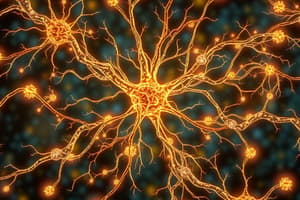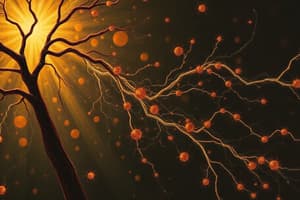Podcast
Questions and Answers
What characterizes phase 1 of the action potential based on the provided text?
What characterizes phase 1 of the action potential based on the provided text?
- Outward flow of calcium ions.
- Decreased K+ permeability.
- Increased Na+ permeability. (correct)
- Simultaneous opening of L-type voltage gated sodium channels.
What phase is characterized by the plateau phase of the membrane potential as a result of an inward flow of calcium?
What phase is characterized by the plateau phase of the membrane potential as a result of an inward flow of calcium?
- Phase 3
- Phase 0
- Phase 1
- Phase 2 (correct)
What causes the sodium gates to be 'inactivated' in phase 0 of the action potential?
What causes the sodium gates to be 'inactivated' in phase 0 of the action potential?
- Favourable concentration and electrical gradient.
- Electric charge distribution across the cell membrane. (correct)
- Rise in intracellular calcium.
- Outward flow of potassium ions.
Which ion contributes to the rise in membrane potential in phase 0?
Which ion contributes to the rise in membrane potential in phase 0?
What brings about the fall in membrane potential close to the potassium equilibrium potential in phase 3?
What brings about the fall in membrane potential close to the potassium equilibrium potential in phase 3?
Which event partly leads to the inactivation of calcium channels in phase 2?
Which event partly leads to the inactivation of calcium channels in phase 2?
During which phase of the cardiac action potential do the Na+ channels close?
During which phase of the cardiac action potential do the Na+ channels close?
What characterizes the 'absolute refractory' period of cardiac myocytes during the action potential?
What characterizes the 'absolute refractory' period of cardiac myocytes during the action potential?
What occurs during phase 2 of the cardiac action potential?
What occurs during phase 2 of the cardiac action potential?
Which statement best describes the 'relative refractory' period in cardiac myocytes?
Which statement best describes the 'relative refractory' period in cardiac myocytes?
What distinguishes cardiac muscle from skeletal muscle and most neurons in terms of resting potential?
What distinguishes cardiac muscle from skeletal muscle and most neurons in terms of resting potential?
How does the calcium current contribute to the action potential in cardiac muscle?
How does the calcium current contribute to the action potential in cardiac muscle?
What is the main cause of the diastolic depolarization (pacemaker pre-potential) in the SAN?
What is the main cause of the diastolic depolarization (pacemaker pre-potential) in the SAN?
What is responsible for the relatively slow and smaller magnitude depolarization phase in the SAN?
What is responsible for the relatively slow and smaller magnitude depolarization phase in the SAN?
Why is the initial resting potential in the SAN less negative than in other parts of the heart?
Why is the initial resting potential in the SAN less negative than in other parts of the heart?
Which type of calcium channels contribute to the acceleration of depolarization towards the threshold potential in the SAN?
Which type of calcium channels contribute to the acceleration of depolarization towards the threshold potential in the SAN?
What potential triggers an action potential in the SAN during phase 4?
What potential triggers an action potential in the SAN during phase 4?
Which ion is responsible for the depolarization phase in the SAN due to its influx through L-type Ca++ channels?
Which ion is responsible for the depolarization phase in the SAN due to its influx through L-type Ca++ channels?
Flashcards are hidden until you start studying


